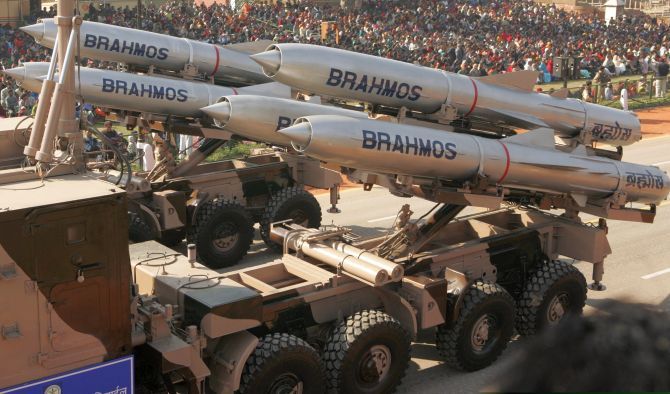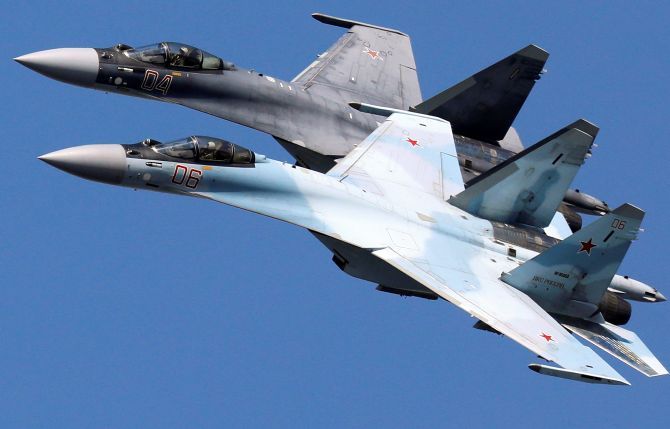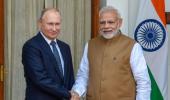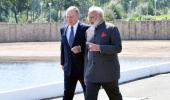Russia -- already India's biggest arms supplier from 2014-18, accounting for 58 per cent of India’s defence imports -- eyes more, reports Ajai Shukla.
On the eve of his two-day visit to Vladivostok for a summit meeting with President Vladimir Putin, Prime Minister Narendra Modi proposed combining Russia’s high technology with India’s low production cost to build weaponry more cheaply. This is already happening, with contracts worth over $12 billion (Rs 86,241 crore) in the pipeline.
In March, the Stockholm International Peace Research Organisation named Russia as India’s biggest arms supplier from 2014-18, accounting for 58 per cent of India’s defence imports. While no big defence announcements are slated for PM Modi’s visit on Wednesday and Thursday, a slew of “Make in India” contracts could ensure Russia holds its position in the years ahead.
These projects are over and above the $5.43 billion contract for five units of the S-400 Long Range Surface to Air Missile System, which was announced at the last Modi-Putin summit last October.
>> Kamov 226T helicopters

Photograph: Maxim Shemetov/Reuters
In 2015, on Putin’s personal request, Modi agreed to buy 200 Kamov-226T utility helicopters for the Indian Air Force and army without competitive tendering. The $2 billion deal involves building 140 Kamovs in Hindustan Aeronautics Ltd, after its joint venture partner, Russian Helicopters, supplies the first 60, fully built.
With this in hand, Russian helicopters are fielding a “navalised” Kamov-226T in the Indian Navy’s tender for 111 “naval utility helicopters”. With its production facilities amortised over the first 200 Kamovs, Russian Helicopters could offer the navy a compelling price of around $1 billion.
>> Kalashnikov AK-203

Photograph: Sergei Karpukhin/Reuters
New Delhi and Moscow have signed an inter-governmental agreement to build 750,000 Russian assault rifles for the Indian army, at a likely cost of about $1 billion. In March, Modi inaugurated an Indo-Russian JV in Korwa, near Amethi, which will soon start manufacturing Kalashnikov AK-203 rifles.
The JV includes the Ordnance Factory Board, with a 50.5 per cent majority stake; Kalashnikov, with a 42 per cent stake, and Russia’s state-owned export agency, Rosoboronexport, owning the remaining 7.5 per cent.
>> Krivak-III frigates

Photograph: Gleb Garanich/Reuters
In October 2018, the cabinet approved the purchase of four Russian Krivak-III class frigates. The first two frigates are lying partially built in Yantar Shipyard, Russia and India will pay about $1.5 billion to complete them, install Ukrainian Zorya gas turbine engines and sail them to India.
Meanwhile, a contract is being negotiated to build the next two Krivaks in Goa Shipyard Ltd.
India already operates six Russian Krivak-class frigates. The first three, INS Talwar, Trishul and Tabar, were commissioned in 2003-2004. Subsequently, INS Teg, Tarkash and Trikand, were commissioned in 2012-13.
>> BrahMos missiles

Photograph: Kamal Kishore/Reuters
The BrahMos missile, which India and Russia co-developed and now co-produce in Hyderabad, is on order for several Indian warships. Last December, the ministry of defence announced that the BrahMos would arm the four new Krivak-III frigates. Each vessel’s BrahMos system, including the “vertical launch system” and missiles on board, will cost Rs 1,250 crore ($175 million).
BrahMos missiles are also on order for the navy’s four Visakhapatnam-class destroyers and will equip the seven Project 17A frigates under production. The total cost amounts to about $2.6 billion.
>> Igla-S

Photograph: Alexander Ermochenko/Reuters
Last November, the ministry of defence announced it had chosen Russia’s Igla-S missile as the “very short range air defence system” for the army, navy and air force.
Russia’s export agency, Rosoboronexport bid $1.5 billion for 5,175 Igla-S missiles and 800 launchers, beating out Sweden’s Saab and French firm, MBDA.
The Igla-S VSHORADS, with a range of eight kilometres, will protect soldiers from enemy combat aircraft that have sneaked through the IAF’s defences. While the Igla-S is an older system, with even the Russian military having switched over to the 9K333 Verba, it presents an affordable option.
>> Sukhoi-30MKI

Photograph: Ilya Naymushin/Reuters
With Hindustan Aeronautics Ltd Nashik completing delivery of its contract to build 222 twin-engine, heavy Sukhoi-30MKI fighters, negotiations are under way for extending the licence to build an additional 18 aircraft.
At HAL’s price of about Rs 450 crore ($65 million) for each Sukhoi-30MKI, the IAF will pay about $1.15 billion for 18 new fighters. Delivery of these could start next year and be completed by 2022, increasing the IAF’s Su-30MKI fleet size to 14 squadrons, or 290 fighters.
Firm agreements between Moscow and New Delhi underlie the $12.25 billion worth of Make in India production mentioned above comprise of. However, the real money lies in three procurements that Russia hopes to corner. These include:
>> Project 75-I submarines
Rosoboronexport is pursuing a navy tender, worth some Rs 50,000 crore ($7 billion) for six new submarines, with “air independent propulsion”, under Project 75-I.
The navy’s 30-year submarine plan calls for building 12 vessels with foreign technology, and the next 12 indigenously. So far, only six Scorpene submarines have been built and Project 75-I is the last chance to obtain foreign technology.
Russia has promised a high degree of technology transfer for building its Amur-class submarines in India. It is competing for the contract with Thyssenkrupp Marine Systems from Germany, Naval Group from France and Kockums from Sweden.
>> Medium fighters
After the 2004 tender for 126 “medium multirole combat aircraft” was aborted with the purchase of 36 Rafale fighters from Dassault, the IAF initiated a fresh acquisition for 114 medium fighters. Two Russian fighters are competing -- the MiG-35 and Sukhoi-35.
Meanwhile, last year the navy initiated the procurement of 57 multi-role carrier borne fighters for its two indigenous aircraft carriers. The MiG-35 is competing for this too.
These are easily the biggest on-going Indian procurements, together worth an estimated $18-25 billion. The Make in India component amounts to 50 per cent of the contract value
However, an obstacle to India’s defence contracts with Moscow is an American law -- Countering America’s Adversaries Through Sanctions Act. This binds Washington to impose sanctions against countries that engage in “significant transactions” with Russian, Iranian and North Korean entities.
While President Donald Trump can grant New Delhi a waiver from CAATSA, there is no certainty that he would.











